 Circling Raven Prophecy, Kay O’Rourke
Circling Raven Prophecy, Kay O’Rourke
This writing project began as a flash of an idea when I first saw artist Kay O’Rourke’s series of thirty paintings, The River Remembers, in Spokane’s Marmot Gallery. I thought how great it might be to have a collection of written somethings to go with these artworks that depict the history of the Spokane River Gorge. My sense was the somethings shouldn’t detract or distract from Kay’s gorgeous paintings. If the writings somehow paid homage to the paintings, I mused—perhaps by taking the same shape (Ah, yes, that magical, sometimes mystical SQUARE!), and if they weren’t too prissy-looking (as regular lineated poems can often appear)—then maybe just maybe the literary enterprise might indeed complement the visual art.
Of course we were talking about an ekphrastic endeavor, and obviously the writings needed to be prose. As in prose poems. Friends at Spark Center, a tutoring center in my neighborhood, helped bring this crazy idea to life. And of course so did the fabulous area writers who threw themselves into this project with such passion. Some of these were novice writers; some were graduates of or students enrolled in Eastern Washington University’s M.F.A. Program. Several were high school students in the Salish Language School, a school that fosters education in traditional tribal language and culture for local Native American young people. This amazing group of area poets and lovers of our river came together, each taking on a painting or two, and “living in it” creatively, roaming imaginatively among its details and history.
Presented here are eight excerpts from the series of twenty paintings and their accompanying prose companions. So many surprising sources of joy fed into this project: the contemplative moments we all spent with the paintings, the intimate engagement of the writers, the stories that poured forth, the prose poems taking shape before us with such gusto, and the history we all learned together of our town and our river. We are grateful to Kay O’Rourke for these marvels of inspiration. I never dreamed all these unexpected sources of delight would, like small feeder streams, enter the great river.
—Nance Van Winckel
§
About the Contributors
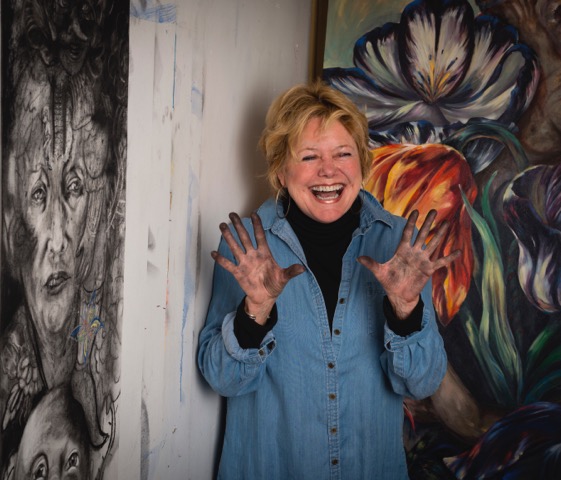 Kay O’Rourke.
Kay O’Rourke.
Photo Credit: Jon Lepper, Tim Halloran Spokane Creative Life
Artist Kay O’Rourke
I work in oil and mixed media large scale drawings. I also play with found objects, creating artistic narratives. My work is narrative in nature, celebrating moments and memorializing them. The images can be about joy, humour, anger and even sometimes fear. I follow all the rules of good art making but let my inner person take me where I must go.
This last year was spent doing a commission of 30 paintings on the History of the Spokane River Gorge from the beginning of time up to Expo 74. I was commissioned by Jim Frank for Kendall Yards in Spokane these works now hang permanently in the Spark Centre at Kendall Yards. These works still represent my way of using “Majic Realism.” I believe Myth and Folk tales give a better sense of history beyond facts.
I’m drawn to naturalism, lyricism and myth. I consider my work to be “Paw Prints” of my life journey, the creation of myth from the ordinary.
The Writers
Megan Cuilla received her MFA from Eastern Washington University. She lives in Spokane, WA, with her husband and pet rats. Her work has been published in Rock and Sling and Knockout.
Once in a moon Jeffrey Dodd emerges from his bungalow in the foothills of North Spokane, shakes his fist, and returns to prune his shopping list.
Brooke Matson’s first full-length collection of poetry, The Moons, was published by Blue Begonia Press in 2012 and was also included in the 2015 Blue Begonia Press boxed set titled Tell Tall Women. Matson’s poems have appeared in Floating Bridge Review, CALYX, and various issues of RiverLit, for which she was the 2014 Poet in Residence.
Kathryn Smith’s poems have recently appeared or are forthcoming in Bellingham Review, Mid-American Review, Florida Review, Bluestem, Cleaver Magazine, and Ruminate. She was a 2013 artist resident at Holden Village, and her work has been nominated for Best American Poetry and the Pushcart Prize. She has an MFA in creative writing from Eastern Washington University and lives in Spokane, WA.
These students from Spokane’s Salish School contributed prose pieces: Ryem Abrahamson, Sierra Bates, Danny Boyd, and Shana Ellingburg.
§
Raven Watching
After the painting Circling Raven Prophecy (#4)
See the reflection in my eye? That is you. It is sunset, or is it sunrise? Sometime before now, a tree branch snapped. The teal-tinted feather that covers my ear moves gently as you move. Everything cries out: the scent of the river. My murder in the sky. The man at the river’s edge. The men who are coming.
We flew from where we rested and now we circle the water, waiting. I used to believe things would be like this, circling and timeless, the banks of the river lush, alive. Things will change, sometimes in an instant, and sometimes forever. My beak is open as I breathe in. Tomorrow, I must remember today. One of my brothers carries a vine.
—Megan Cuilla
.
The Flowing Clock
After the painting Spokan Chief Garry (#7)
As I look down the stream, I see in it the generosity and unconditional love it sheds on my people. As I listen, it whispers along the shore all the uncanny secrets of life. We learn from the river; our way of life is like the river. We appreciate that every deed pours into the vast ocean of unknown; yet we stay as composed as the river floating through the luminous meadow. Giving back to our relations, we exist as the river, the people of this land. But as I look at the clock, I see they’re just like the clock, always ticking, running around in circles, running out of time. I begin to question, what happens to the clock as it drowns into the river? Will it keep ticking? Or muddle in the grasp of the water? The ticking stops, and the water talks. Listen.
*Translation notes: Spokan is Salish spelling of the anglicized Spokane.
— Sierra Bates
.
Hope
After the painting The Indian Wars (#8)
I am a spirit, who was once a little girl. I thought after death would mean that I would be with the spirits, but when the spirit of death chose me, I was in the clouds, watching over my tribe and my family, until I do something good for my tribe. Then the syapé came, killing our horses and our people, and the spirit of death picked the horses’ spirits one by one.
I looked at the sky, which was red from the blood of the horses. I looked at my grandparents, my grandmother, crying, holding onto my grandfather as tight as she could, my grandfather, crying on my grandmother’s shoulder, wishing that hope could be as big as the sun. But at that time, it seemed that hope was smaller than the palm of his hand.
I promise that the next day, I will make hope bigger than the sun, bigger than anything. Not so that I could be with the spirits, but so there will be happiness in my tribe once again.
—Danny Boyd
.
Legend
After the painting Indian Canyon Falls (#9)
Heron watches the Falls
The secret to stillness is to tell yourself a story. Once upon a time there was a face in the falls. I tilt my head to feel the spray. Once upon a time he saw me. I tilt my tilted head, turn a widened eye. I am wondering, a wonder. Once upon a time he wandered. My face faces its own direction, something to do with motionlessness. Something in the water. In the light. Once upon a time a creature ceased flight. It’s something to do with flying forever. I will not disturb the water.
The Falls watch Heron
I am almost not here—cascade of my arms, the way I wear water and water wears me. One heron tilts its head, one leg raised toward…. The men broke camp; the new camp came. Only the horse gave notice. I thought death would be like floating on the water’s face forever. Then the herons came, their blue-gray feathers like a cloak tipped with light, and now I think it’s something to do with perpetual motion. They embody stillness, my opposite (I am ever moving, never constant, ever present). Part of me is water, part is air. I never grow cold.
—Kathryn Smith
.
Only Lies Remain
After the painting The Hanging of Qualchan (#11)
Qualchan is my name. I am strong.
I was surrounded, but I was not defeated.
My wife Whistalks, my brother Lotout, and I were trapped by the white man. They didn’t expect me to go in with my head held high. Nor did I expect them to break our treaty. We were supposed to bring the white flags, but instead they brought rope and deceit. Twenty-seven already gone, and the three of us stand strong while they hold my father hostage. They tricked us. They’re liars! My throat may be snaked with the string of the wrong, but the fire in my heart will never die out. Hi čn yoyot. I am strong.
Tomorrow I must warn my people! Tomorrow I must tell them of the “Indian Land For Sale” and the “Have a Home of Your Own” that will appear on paper directed towards the foreigners of this land.
HI ČN YOYOT. QUALCHAN ŁU I SKWEST
—Ryem Abrahamson
.
The Empire Builder’s Lament
After the painting James Jerome Hill (#18)
This idle leaves room for the goats to wander and taunt the wiry little dogs whose herding days are short. Not good. And giving the lean-about boys time to relax is not good for their industry or their understanding of provision. Even when we’re still, I’m to keep working out my fear and trembling. This land will never claim its own bounty.
When we move, all dominion moves with us and those boys are lumping coal into the box quicker than my little Lindell runs to fetch his pigs when they get a slop of liberty. We cut through Minnesota and Dakota so fast you could see Providence. Hear His voice calling out from the drive wheels: ta-lith-a cu-mi, ta-lith-a cu-mi, ta-lith-a cu-mi. And the prairie did rise.
Whatever future’s far shore we wash up on, this work multiplies in us like the bunched buffalo grass on the plains. Like Lindell’s little cutlets squeeing all over creation, and the voices boiling up from the steam. The other night, big harvest moon calling us home, I wondered if I’d see them again on this side. Even here, elbows deep in this valve chest, a voice calls cu-mi, and I am yet complete.
—Jeffrey G. Dodd
.
Four Faces
After the painting Union Depot Demolished (# 28)
I am the silent observer. The beauty of repetition, a stem of possibilities. I am time. I cannot fall. I have to stay strong even though the walls surrounding me are my prison. Keeping me locked away from the outside world. Allowed to look but not touch. That is my punishment.
As the world around me collapses, I remember the very beginning. The people. The plants. The life. The peace. I remember years later, a happy couple boldly dancing on the dirt, sharing their joy with the world. I remember the freedom, back before I was put in my tower, trapped. Now all I see is broken pavement. I don’t know or understand why the world around me collapses. Beneath my numbers, I see destruction. A crashed train, broken cords, a light holding on to all it has left: its color. Red.
I wish I could leave my prison and bravely help the world pick itself back up. I strive to help but no one opens the door to my eternal cage where I am confined.
Tomorrow I will continue to focus on the beautiful repetition and on the way the wind feels on my 365 stones. But today I mourn and put on four faces: strong, bold, brave and fierce. I will prove to the world that not everything can be demolished.
—Shana Ellingburg
.
The New Season
The Herbert H. Hamblin Conservation Area (# 30)
 The Herbert H. Hamblin Conservation Area
The Herbert H. Hamblin Conservation Area
To live in rivers is to live among mirrors. My family—we are grafted from one another, sprouting along the river rock like lichen. I have mistaken their wings for mine, recognized their coal-black beaks dipping among the yarrow and felt my own hunger raise its neck. Once I looked into my own eyes and saw a raging falls, a red stream of salmon twisting like a muscle across the land, a fire running with yellow feet across the bodies of trees.
A moment ago, I floated among the sedges—the ones with roots that taste like the caps of mushrooms—the water smelling of rusted steel. Goslings pushed their tiny bodies across the current, following their mother’s wake like beads of dew running across a spider’s thread. Then I tasted the delicate, warm dust, bitter with the sap of unfamiliar trees. It fell around us like a new season.
Maybe it is the sun pausing like a hot ember in the clouds, or maybe it’s the scent of burnt feathers mingled with pine, but my sister says the word first. My call follows hers—like the goslings following their mother—and then we are all calling with our blackened mouths, the memory lifting us like a many-winged river from the earth. I glide higher among the flock, heart pounding, and as I do, the sun itself flies down to rest on the water—fanning its red wings.
—Brooke Matson
.
Nance Van Winckel’s newest book is Ever Yrs, a novel in the form of a scrapbook (Twisted Road, 2014). Book of No Ledge, an altered encyclopedia, will appear with Pleiades Press’s Visual Poetry Series in November 2016. Nance teaches in Vermont College of Fine Arts’ MFA in Writing Program and lives in Spokane, WA.
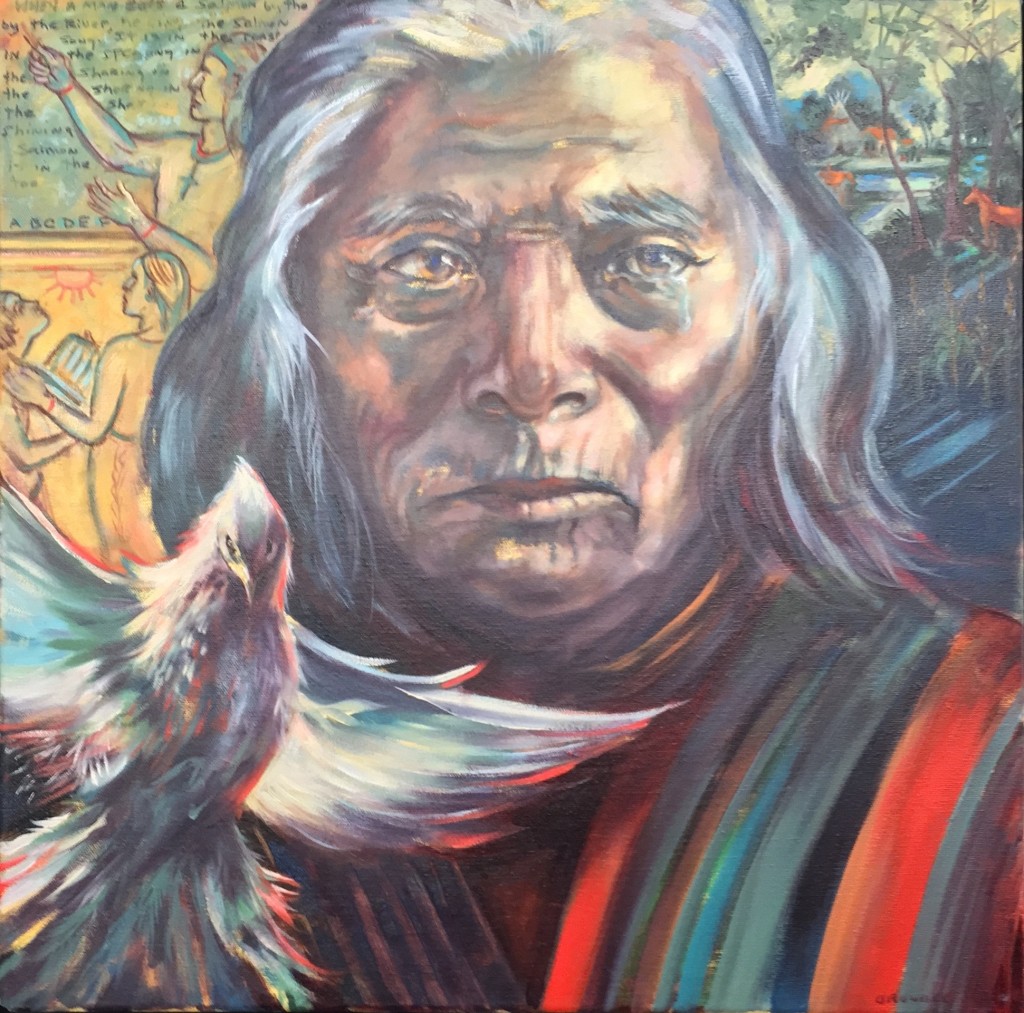



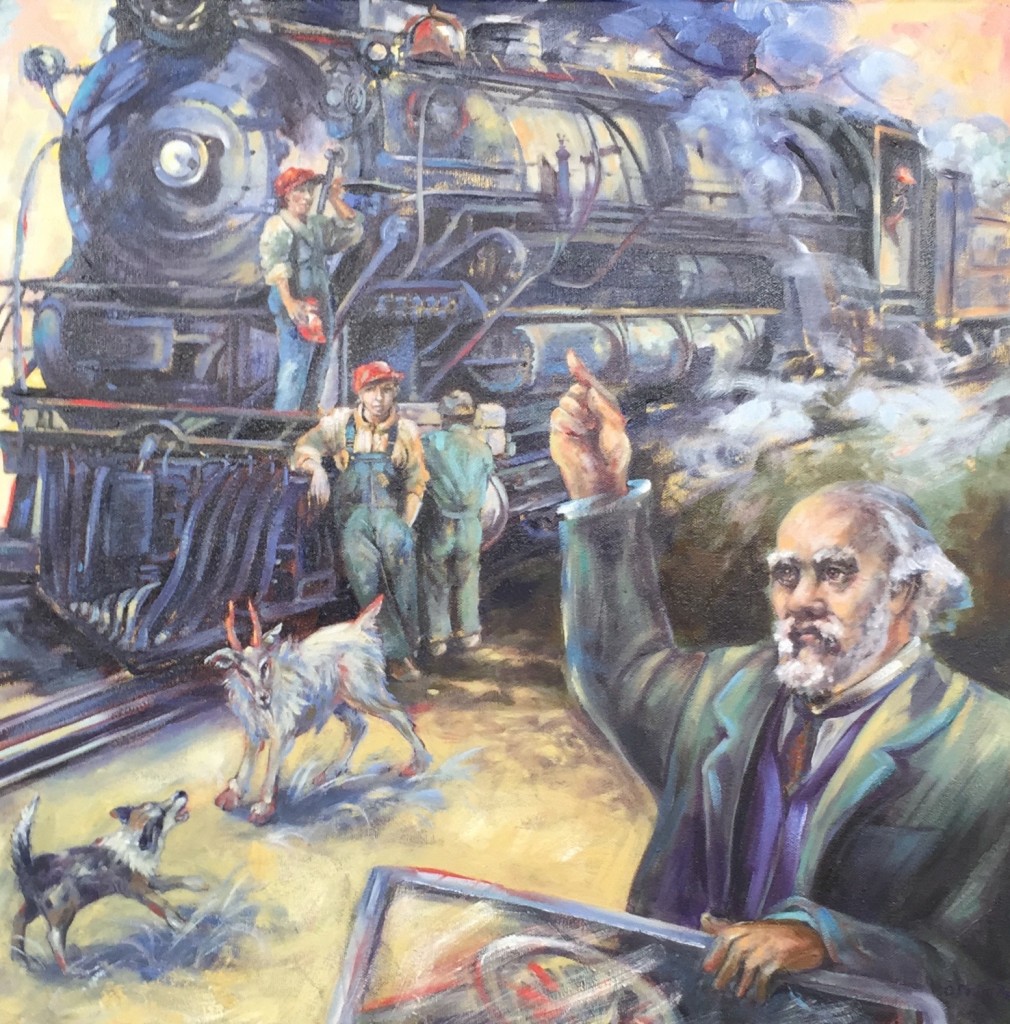
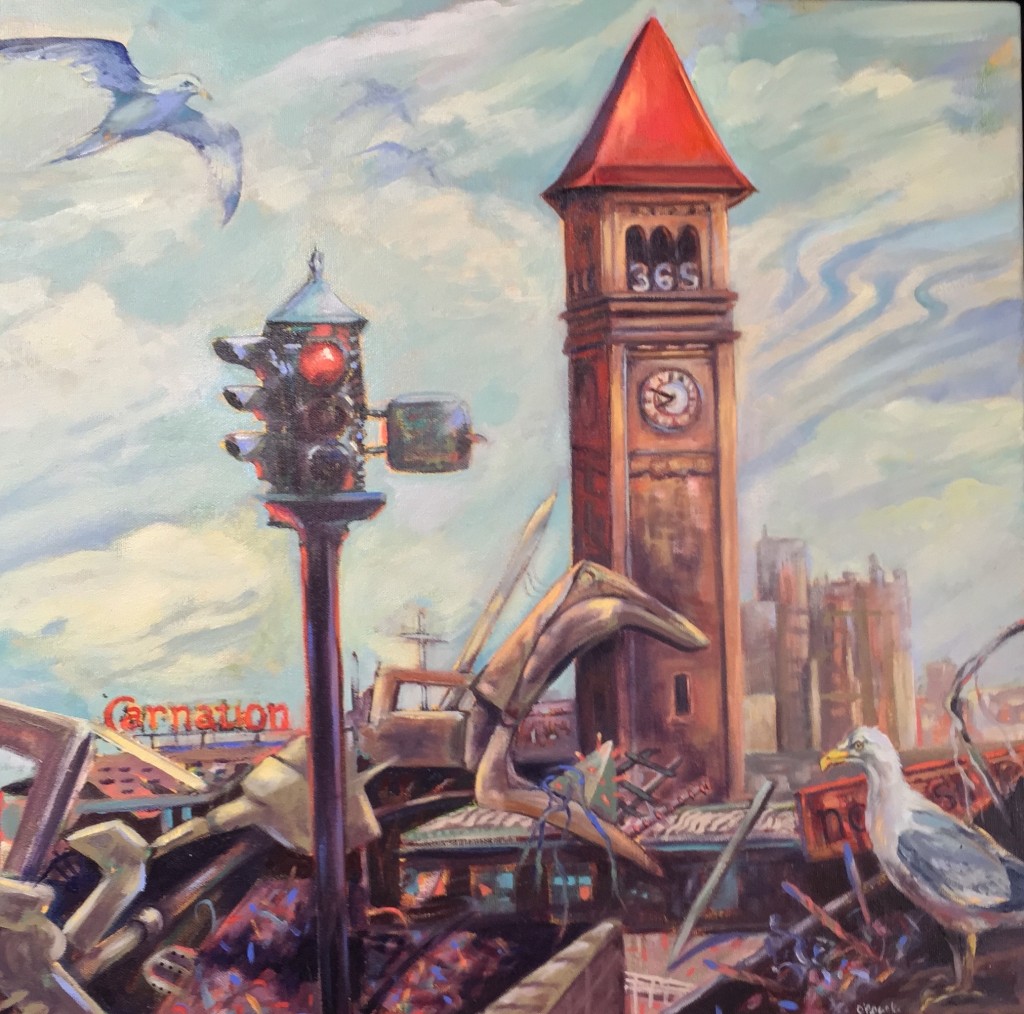
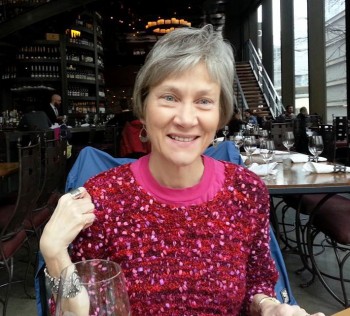
What a pleasure. Thanks, Nance, for linking these writers and images.